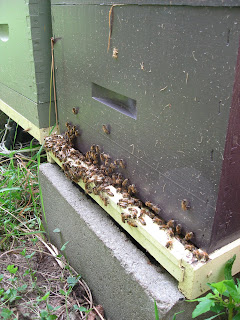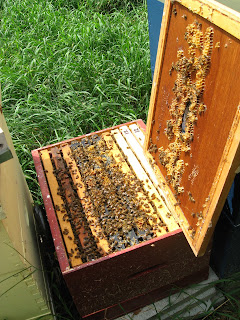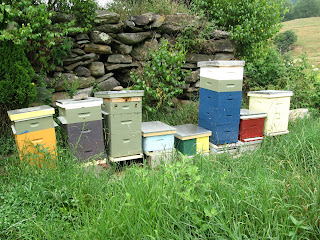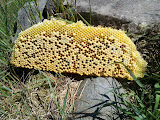Thursday, August 16, 2012
2012-08-05: Supers are Growing
Orange: Bees were bring in orange pollen. Some of the honey cells are being capped in the super. Did see some brood in the super. Will have to add the queen excluder next week to keep the queen out.
I looked into the top deep (or brood) box. There was one frame that was only partially drawn and another that was solid honey. No doubt the former was one of the frames I put in after removing frames for the double nuc. Dusted the top with powdered sugar.
Purple: Bees were bring in orange pollen. There was also bearding especially in the back entrance (which I still have not fixed).
The honey super is filling up, the cells are about 1/2 filled and there is white wax (i.e. new wax).
The brood frame has only one capped cell. I should remove the drones next week. Dusted.
Green: Bees were bring in orange pollen. Bees are starting to draw out the frames in the new super.
I pulled one of the frames from the top deep box and it was filled with honey, a very good sign. Dusted.
Dark Green: Bees are drawing out the frames in the top brood box.
Double Nuc Yellow: Just starting to draw out the frames in the top box. Start feeding with sugar syrup to promote comb building and winter storage?
Double Nuc Green: Some orange pollen being brought in.
Blue: Did not spend much time as a storm was coming.
Red: Found a supersedure queen cell on the side of one of the frames. Carefully slid it back. A new queen might be a good thing for this hive as it has been an underpreformer. Dusted.
Yellow: The bees are doing a good job of drawing out the frames in the top deep box and the cells are half full of honey.
2012-07-22: The End of Drones?
Orange: The super remained uncapped. I am not sure if the bees are making much headway to filling it up with honey. There was a green plastic drone frame with capped drone that I removed and replaced with bare foundation. The chickens did manage to pick off the brood from the plastic foundation, but its messy and I think I do prefer just using frames that the bees build their own drone frame in.
I did dust this hive with powdered sugar.
Purple: As you can see in the picture, the bees are not drawing out the foundation in the super. There was also a drone frame that had some capped brood, so I cut it out and slipped it back into place. The chickens also enjoyed them as well. I then dusted this hive.
Green: I decided to add another super to this hive. I had medium frames ready to go but only a shallow box, so I used a spacer (normally used to put on top of the hive under the inner cover to provide room for pollen patties and certain medication treatments) underneath the new super to allow enough space for the medium frames to fit. I will want to replace this soon with a proper medium box.
There was a lot of activity while I was doing this work. I believe the reason was that since this hive uses its top entrances so heavily, the foragers were coming back and didn't know where to go when I had the top super off. I may think about what to do in the future to keep them happy. I might try placing the top boxes on a neighboring hive to see if that will make them happy or not.
I dusted this hive.
Swarm/Dark Green: The bees had built some comb upwards into the empty space in the old box. I removed both the extra comb and the empty top box.
Blue: There was some activity on in the second super, I need to add more frames next time. In the top deep, there was a drone frame inside which was completely drawn out with large drone sized cells, but there was only a handful of brood inside, all of which were capped. Evidently the bees are ramping down on production of drones as the season progresses. I removed the few cells of brood and put the frame back in.
Red: Did not open.
Yellow: The bees are not using all of the top box yet. Dusted.
2012-07-15: Sprucing Up the Swarm
This was a very quick visit to the apiary. I mostly there to just pop my head into the double nuc in order to remove the queen cages. Both queens had been released and were busy laying eggs. I found and removed 3 supersedure cells in the green side. These where probably made by the bees when they were moved before they accepted their new queen. By removing them I wanted to make sure there would be no fights when they emerged. In one of these pictures you can see the queen (marked with yellow) making her rounds.
I did have time to move Swarm from its ghetto deep box into a brand new hive box painted a dark green... so henceforth Swarm will be Dark Green. In addition to the picture of the frames in the process of being moved to the new box, there is also a close up of one of these frames showing a frame of brood with some empty cells. I placed the old brood box, empty of any frames, on top of the new box in order to help the foragers currently out in the fields to of find their way back to their new home.
2012-07-08: Nuc the Entire Site from Orbit
That morning I had swung by Mike Palmer to purchase two of his queens to allow me to build a 'double nuc'. A nuc being a small hive. The double nuc design is more or less a regular deep with a divider down the middle and an entrance in the back for one of the chambers instead of the front of the hive. By housing two colonies together like a duplex, the hope is that they will winter better (since they are warmed on one side by the other colony) and they can be used in the Spring to replace winter losses. One queen came from an old hive of his that has been a stellar honey producer over the years and to which he has not had to do much in the way of medication. While that hive no doubt has superseded several times over the years, the genes inside should behoove well for any queens from it. The other queen was a decedent of a queen that Mike had gotten from a no treatment apiary. An infusion of anti-mite genes is a good thing. I liked the fact that they were two unrelated queens which further increases the genetic variety of my own apiary since these queens will produce drones that will have a chance to breed with any virgin queen (in the aftermath of a swarm or as part of the process of a supersedure or a split) in my apiary.
After getting them back to my apiary I had to assemble the double nuc. I had the woodenware ready. One side I had painted a dark green and the other I had left a lemon yellow (I had bought the woodenware used from a beekeeper that was downsizing). For each new colony I would need to supply a frame of brood, a frame of honey, a frame of some brood and honey or pollen, and an empty frame (foundation would suffice). I decided to build the yellow half from Yellow using the queen from Mike's strong producer hive. I figured that Yellow was strong and could loose some brood... and also it would be easier to remember who I got them from. Last year I had done this process and had discovered that the hive I had planned to take frames from had superseded which caused some anxiety at the time. Things when much smoother this time.
I proceeded to build the green side from Blue, since Blue was the most populous hive though it might ding its honey production. I managed to bring over more nurse bees as well during this process than last year (especially the green side) and I hope that will help them build out stronger than the double nuc I made last year.
I probably should have used Red as the source of bees since its not taking off and it would be better to sacrifice a weak colony rather than sap the strength of strong colonies who could use that extra strength to make even more honey. But I wanted to give Red a little more time before culling it to see if it might take off.
I did decide to just remove the top box from Red, I needed a frame of foundation for each of the new nucs and they were not doing anything with it yet. This would give them the time to finish building out the bottom box.
I didn't have the time to work much with the other hives. But I did manage replace the scrap piece of plywood on the Swarm hive with a proper top cover.
After getting them back to my apiary I had to assemble the double nuc. I had the woodenware ready. One side I had painted a dark green and the other I had left a lemon yellow (I had bought the woodenware used from a beekeeper that was downsizing). For each new colony I would need to supply a frame of brood, a frame of honey, a frame of some brood and honey or pollen, and an empty frame (foundation would suffice). I decided to build the yellow half from Yellow using the queen from Mike's strong producer hive. I figured that Yellow was strong and could loose some brood... and also it would be easier to remember who I got them from. Last year I had done this process and had discovered that the hive I had planned to take frames from had superseded which caused some anxiety at the time. Things when much smoother this time.
I proceeded to build the green side from Blue, since Blue was the most populous hive though it might ding its honey production. I managed to bring over more nurse bees as well during this process than last year (especially the green side) and I hope that will help them build out stronger than the double nuc I made last year.
I probably should have used Red as the source of bees since its not taking off and it would be better to sacrifice a weak colony rather than sap the strength of strong colonies who could use that extra strength to make even more honey. But I wanted to give Red a little more time before culling it to see if it might take off.
I did decide to just remove the top box from Red, I needed a frame of foundation for each of the new nucs and they were not doing anything with it yet. This would give them the time to finish building out the bottom box.
I didn't have the time to work much with the other hives. But I did manage replace the scrap piece of plywood on the Swarm hive with a proper top cover.
2012-06-30: Feeding the Chickens
On this warm day most of the hives had some bees fanning air in front of the entrances to the hives to improve ventilation. Green and Blue, being the largest hives also had the most fanners. My objective for the day was to apply powdered sugar dustings to most of the hives in my ongoing effort to keep the mites in check as well as to check on the general condition of each hive.
Orange: Last week I had added a (shallow) super with frames of drawn comb, and there were traces of nectar in some of the frames. I dusted the top brood box and super since I didn't want to crack it open to check on the bottom brood box.
Purple: Last week I had added a (medium) super made of frames of undrawn com (i.e. just foundation). I could not see any sign of the bees starting to draw that foundation into honeycomb yet. I didn't make a note as to if I dusted or not.
I took photos of a drone frame in place and pulled out of the hive. This was an experiment. Done frames, i.e. frames that have foundation sized for the larger drone larvae, are added by some beekeepers to their hives so that drone brood will be raised there and the mites that preferentially seek out drone brood will crawl in with them to breed. The beekeeper can then easily pull that frame out when the drone brood are capped and dispose of the brood and the mites, generally by scrapping the frames on site or freezing them and then scrapping them off or putting them back into the hive for the bees to clean out. The downside of this is that its a bit of a hassle to freeze and scrape them (and also rather gross). Bill Mares last year had given away many of his green plastic drone as he had switched over to using regular frames in which he had placed a starter strip of comb. The theory being that the bees would draw out their own comb underneath the starter strips and will almost always draw out drone comb as most hives with foundation are (in the bees' minds) woefully short places to build drone cells. The beekeeper can then just pull the frame when the drone cells are capped and cut out comb, and then insert the frame back into the hive. As can be seen in the picture, the gals have drawn out the starter strip with cells in which they have loaded with honey and capped, but below they have built the larger drone frames and in which there are little future drones developing.... unless I get to them first! They might be capped next week and I will remove them then.
Green: Last week I had added a (shallow) super with frames of undrawn comb and the gals had started drawing it out from the front of the hive backwards. The front of the hive is where this particular hive has both an upper entrance in the inner cover and additional holes drilled into the front of the super. I had drilled them to allow additional bee traffic (since this hive insisted on using its narrow upper entrance to the exclusion of the wide bottom entrance) and additional ventilation (the idea being that during the heat of summer, better ventilation will mean fewer bees having to ventilate the hive to keep it cool and to cure the nectar into honey). I did not make a note as to if I dusted it or not.
Swarm: The queen had made herself at home and there was a frame of capped brood, it some degree of a 'shot gun' scattering of empty cells indicative of non-perfect egg laying or some other problem, but probably not to a dangerous level. There was also a frame of honey (not sure if new or if I had given it to them when I moved them in) so they do have some reserves.
Blue: The medium super on top of blue was halfway drawn out. There also seemed to be a large number of young bees (paler in color, fuzzier than older bees). I did not note down if I dusted.
As I discussed with Purple, this hive had a starter strip drone frame in it. However, this frame was mostly capped and I did cut out the drone cells with my hive tool. It was a pretty easy procedure. I noticed that there were many cells in which I could see the dark mites squirming around inside. The cut out comb was then tossed into the chicken yard where, after some initially dubious pecks, the ladies had a bee larvae feast.
Red and Yellow: I didn't make any notes for these hives though I believe Red was noticeable in that the frames in the top brood box had not been drawn out at all.
Orange: Last week I had added a (shallow) super with frames of drawn comb, and there were traces of nectar in some of the frames. I dusted the top brood box and super since I didn't want to crack it open to check on the bottom brood box.
Purple: Last week I had added a (medium) super made of frames of undrawn com (i.e. just foundation). I could not see any sign of the bees starting to draw that foundation into honeycomb yet. I didn't make a note as to if I dusted or not.
I took photos of a drone frame in place and pulled out of the hive. This was an experiment. Done frames, i.e. frames that have foundation sized for the larger drone larvae, are added by some beekeepers to their hives so that drone brood will be raised there and the mites that preferentially seek out drone brood will crawl in with them to breed. The beekeeper can then easily pull that frame out when the drone brood are capped and dispose of the brood and the mites, generally by scrapping the frames on site or freezing them and then scrapping them off or putting them back into the hive for the bees to clean out. The downside of this is that its a bit of a hassle to freeze and scrape them (and also rather gross). Bill Mares last year had given away many of his green plastic drone as he had switched over to using regular frames in which he had placed a starter strip of comb. The theory being that the bees would draw out their own comb underneath the starter strips and will almost always draw out drone comb as most hives with foundation are (in the bees' minds) woefully short places to build drone cells. The beekeeper can then just pull the frame when the drone cells are capped and cut out comb, and then insert the frame back into the hive. As can be seen in the picture, the gals have drawn out the starter strip with cells in which they have loaded with honey and capped, but below they have built the larger drone frames and in which there are little future drones developing.... unless I get to them first! They might be capped next week and I will remove them then.
Green: Last week I had added a (shallow) super with frames of undrawn comb and the gals had started drawing it out from the front of the hive backwards. The front of the hive is where this particular hive has both an upper entrance in the inner cover and additional holes drilled into the front of the super. I had drilled them to allow additional bee traffic (since this hive insisted on using its narrow upper entrance to the exclusion of the wide bottom entrance) and additional ventilation (the idea being that during the heat of summer, better ventilation will mean fewer bees having to ventilate the hive to keep it cool and to cure the nectar into honey). I did not make a note as to if I dusted it or not.
Swarm: The queen had made herself at home and there was a frame of capped brood, it some degree of a 'shot gun' scattering of empty cells indicative of non-perfect egg laying or some other problem, but probably not to a dangerous level. There was also a frame of honey (not sure if new or if I had given it to them when I moved them in) so they do have some reserves.
Blue: The medium super on top of blue was halfway drawn out. There also seemed to be a large number of young bees (paler in color, fuzzier than older bees). I did not note down if I dusted.
As I discussed with Purple, this hive had a starter strip drone frame in it. However, this frame was mostly capped and I did cut out the drone cells with my hive tool. It was a pretty easy procedure. I noticed that there were many cells in which I could see the dark mites squirming around inside. The cut out comb was then tossed into the chicken yard where, after some initially dubious pecks, the ladies had a bee larvae feast.
Red and Yellow: I didn't make any notes for these hives though I believe Red was noticeable in that the frames in the top brood box had not been drawn out at all.
Subscribe to:
Posts (Atom)



































